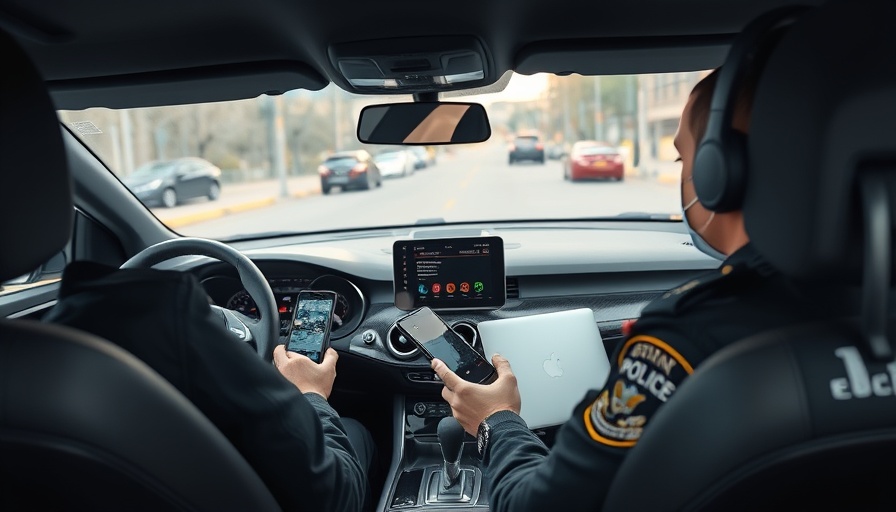
Phoenix PD Deploys Robotic Dog 'Spot' to Elevate Safety in Haute Policing


How Emerging Technologies Will Transform Digital Evidence in Policing
Update The Transformative Role of Emerging Technologies in Policing The world of professional policing is rapidly evolving due to the advent of advanced technologies. As devices multiply and integrate into daily operations, the implications for digital evidence collection and management are profound. Today's law enforcement agencies are not just handling traditional evidence; they're grappling with vast amounts of data generated by smart devices and applications. These advancements promise to transform the landscape of digital evidence, offering both opportunities and challenges. Understanding the Benefits and Challenges On one hand, cutting-edge technologies like AI analytics and body-worn cameras are enhancing the operational capabilities of police forces worldwide. These tools can streamline evidence collection, improve data analysis, and facilitate quicker responses to incidents. However, they also introduce new complexities. The sheer volume of data can overwhelm current systems, often leaving agencies struggling to manage and interpret it adequately. Implementing these technologies requires not only investment in equipment but also training personnel to leverage these tools effectively. Agencies must assess their readiness to adapt their policies and operations in light of these innovations. Consequently, the question of how to integrate these emerging technologies into existing frameworks is pressing. The Need for Preparedness in Law Enforcement Law enforcement leaders must prioritize awareness and capacity building to embrace these advancements. This involves staying updated on technological developments and understanding their potential impacts on agency operations. Not only is it vital to adopt technology, but also to establish protocols governing their use to ensure they enhance efficiency without compromising civil rights. Future Predictions: Navigating the Digital Evidence Landscape As technology continues to advance, its role in collecting and interpreting digital evidence will only grow. What can law enforcement expect in the years ahead? The trend suggests a shift toward more autonomous systems, capable of real-time data processing and analysis. This could be a game-changer, allowing for faster decision-making processes in critical situations. Counterarguments: The Risks of Data Dependency However, there are voices of caution regarding heavy reliance on technology within policing. Critics argue that an over-dependence on digital systems may lead to potential biases inherent in algorithms or even malfunctioning devices. Ensuring accuracy and accountability in digital evidence is paramount, and agencies must remain vigilant to these risks while integrating innovative tools. In summary, the impact of emerging technologies on digital evidence in policing is a double-edged sword. While the potential for enhanced operational efficiency is considerable, the associated risks cannot be overlooked. Agencies that proactively address these challenges and invest in training and resources will be better positioned to navigate the evolving landscape of law enforcement technology. As the integration of technology in law enforcement grows, so does the opportunity for agencies to rethink how they operate. It's time to embrace change and prepare for the future of policing—where technology not only supports law enforcement but also strengthens community trust and accountability.

Discover the Latest Innovations in Policing from the IACP 2025 Tech Conference
Update Harnessing Tomorrow's Tools: Insights from the IACP 2025The IACP 2025 Technology Conference, held from March 5–7 in Indianapolis, served as a vibrant gathering for over 1,000 law enforcement professionals, policymakers, and academic researchers. This year's event highlighted a diverse array of emerging technologies tailored to elevate policing practices worldwide.Networking at Its Best: Bridging Gaps in PolicingWith over 100 exhibiting companies and more than 50 workshops, attendees engaged in invaluable discussions. This facilitated a unique opportunity for networking, allowing participants to share experiences and strategies that could foster collaboration among different police departments. Networking doesn't just enhance knowledge; it opens avenues for partnerships that can lead to shared solutions.Technological Innovations: Redefining PolicingThe conference showcased groundbreaking tools designed for modern law enforcement. Innovations such as body-worn cameras and AI-driven analytics were at the forefront, emphasizing their potential to improve operational efficiency and transparency. These technologies not only aid in evidence collection but also play a pivotal role in building community trust.Workshops that Matter: Learning from the ExpertsAttendees had the chance to participate in various workshops meant to impart actionable insights. Topics covered included crime prediction software, advanced data processing, and community engagement techniques. The practical applications discussed during these workshops are essential for adapting to the fast-paced technological landscape.Looking Ahead: Future Implications for Law EnforcementAs we look to the future of policing, the insights gleaned from the IACP 2025 technology conference will undoubtedly influence how law enforcement adopts new methods and technologies. Agencies that invest in these innovations are likely to enhance their operational capacity and, more importantly, their relationship with the communities they serve.Why Staying Updated MattersUnderstanding the evolving landscape of law enforcement technology is critical—it's not merely about keeping up with trends but about being proactive in ensuring safety and transparency. The tools and knowledge shared at this conference equip attendees to face contemporary challenges head-on.For those unable to attend the IACP 2025 Technology Conference, exploring online resources, such as recorded workshops and discussions, will provide the same valuable insights, ensuring no one is left behind in this technology-driven era.

How LAPD's Mobile-First Approach is Revolutionizing Policing.
Update Revolutionizing Policing Through Digital Connectivity In an era where smartphones dominate daily life, the Los Angeles Police Department (LAPD) exemplifies how a mobile-first approach can redefine modern law enforcement. The LAPD has taken bold steps to embrace mobile technology, integrating devices ranging from smartphones to tablets into the daily operations of its officers. This paradigm shift reflects a deeper necessity for police to operate effectively in a highly connected world, underscoring the importance of fostering community relationships and enhancing operational capabilities. The Importance of a Mobile-First Mindset Shifting to a mobile-first mindset is more than a technological switch; it’s a strategic transformation aimed at improving efficiency and service delivery. For the LAPD, equipping officers with smartphones and connecting them to the FirstNet broadband network represents a conscious effort to modernize policing. As police agencies recognize that traditional radios and mobile data terminals (MDTs) are becoming outdated, the mobile device emerges as a key tool for ensuring effective communication. Untethered from Tradition: Navigating Modern Challenges The LAPD’s choice to utilize FirstNet for their communication infrastructure highlights a crucial aspect of modern policing: reliability. This network, created specifically for first responders, ensures that LAPD officers can communicate seamlessly, even during peak usage times when regular networks may falter. With features like priority access and preemption, FirstNet empowers officer connectivity, proving invaluable in maintaining public safety during crises. Enhancing Community Engagement Through Mobility As officers leverage mobile technology, the benefits extend directly to their interactions with the community. One particularly noteworthy implication is the ability to complete forms and paperwork in the field, allowing officers to spend less time tethered to police stations and more time connecting with local residents. This 'on-the-go' paperwork approach fosters trust, encouraging productive dialogues between law enforcement and citizens. The LAPD’s commitment to reducing bureaucracy and enhancing visibility reflects a broader trend that could lead to more engaged and informed communities. Real-Time Data Sharing: A Game-Changer for Law Enforcement There’s no denying that data is the lifeblood of informed decision-making. By transitioning to mobile technologies, the LAPD enhances its capability to capture, share, and act on data in real-time. A pertinent example includes immediate access to critical information during emergencies, ensuring that an officer’s situational awareness is informed and precise. Moreover, the increased transparency facilitated by real-time data can create a stronger foundation of trust between law enforcement and the community. The Road Ahead: Future Trends in Policing As the LAPD continues to iterate on its mobile-first approach, it sets the stage for a future where technology and policing are seamlessly intertwined. The integration of AI and real-time analytics is on the horizon, offering exciting possibilities for predictive policing and enhanced crime prevention measures. However, as we anticipate these advancements, it’s vital to also consider the ethical implications of technology in policing and ensure that community trust remains at the forefront of these innovations. Concluding Thoughts: Embracing Change for Better Service In summary, the LAPD exemplifies how a commitment to mobile technology can revolutionize law enforcement practices. By focusing on connectivity and real-time data sharing, the department not only enhances operational efficiency but also fosters deeper community relationships. As other law enforcement agencies look to modernize, they can draw valuable lessons from the LAPD’s innovative approach. Embrace change, leverage technology, and connect with the community – the future of policing is indeed mobile.
 Add Row
Add Row  Add
Add 

 Add Element
Add Element
Write A Comment